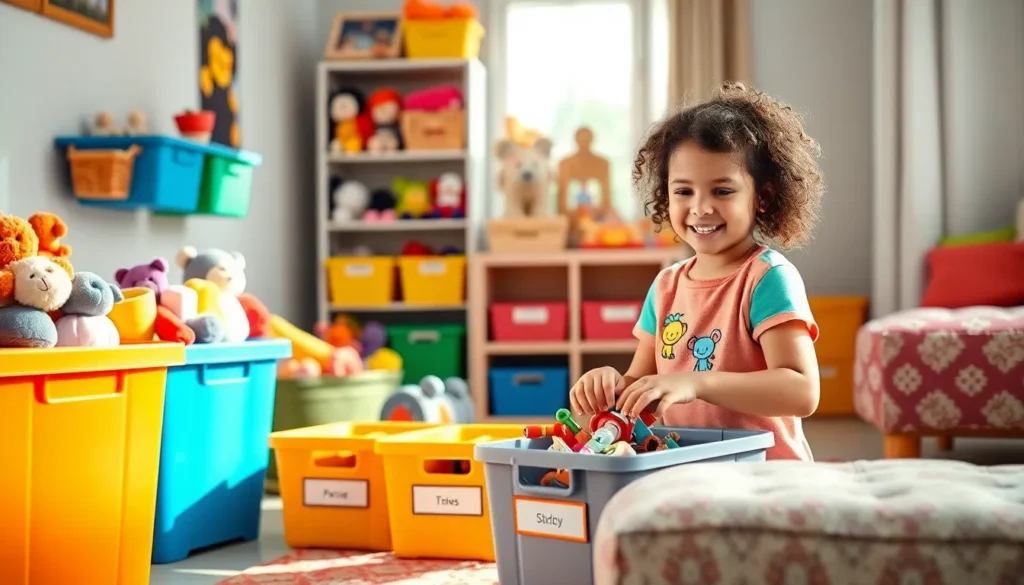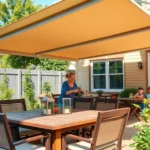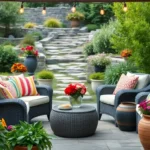Toys scattered across every room in your home? We’ve all been there. The endless battle against plastic dinosaurs under the couch and building blocks hiding in kitchen corners can feel overwhelming for any parent or caregiver.
Effective toy storage doesn’t have to expensive or require a complete home makeover. With the right strategies and creative answers we can transform chaotic playrooms into organized spaces that actually encourage kids to clean up after themselves. From budget-friendly DIY projects to clever storage hacks that maximize small spaces we’ve discovered practical ideas that work for real families.
Whether you’re dealing with a dedicated playroom or trying to contain toys in shared living spaces these storage answers will help you reclaim your home while keeping playtime fun and accessible. Let’s explore smart ways to organize toys that’ll save your sanity and teach kids valuable organizational skills.
Creative Toy Storage Ideas for Small Spaces
Small spaces demand smart answers that maximize every square inch. We’ve discovered innovative approaches that transform overlooked areas into efficient toy storage zones.
Under-Bed Storage Bins and Drawers
Under-bed storage bins transform wasted space into a treasure trove of organized play items. Rolling bins with wheels make accessing toys effortless for children while keeping everything hidden from view. Clear plastic containers allow kids to see their favorite toys without pulling everything out first.
Shallow drawers work perfectly for small toy collections like action figures, building blocks, and create supplies. Custom built drawer systems can accommodate exact toy dimensions and create designated spots for different categories. Pull-out trays with dividers keep small pieces sorted and prevent the dreaded toy avalanche when searching for exact items.
Low profile bins fit seamlessly under most bed frames and can store larger items like stuffed animals, dress-up clothes, and board games. Fabric bins with handles make cleanup time easier and add a softer touch to bedroom decor. Vacuum sealed bags compress seasonal toys and free up valuable storage real estate.
Wall-Mounted Toy Organizers
Wall-mounted systems capitalize on vertical space without cluttering floor areas. Pegboard installations create customizable storage that adapts as toy collections change and grow. Hooks, baskets, and shelves can be rearranged to accommodate different sized items and play preferences.
Floating shelves display favorite toys while keeping them accessible for daily play. Corner shelving units use awkward spaces that typically go unused and create attractive toy showcases. Mesh pockets mounted on walls hold balls, outdoor toys, and stuffed animals in clear view.
Magnetic strips attached to walls organize toy cars, building pieces, and other metal toys in fun patterns. Wall cubbies with fabric bins create a colorful storage system that doubles as room decoration. Rail systems with hanging baskets can be installed at child-friendly heights for independent cleanup.
Multi-Functional Ottoman Storage
Multi-functional ottomans serve double duty as seating and hidden storage compartments. Cushioned tops provide comfortable spots for reading, playing games, or putting on shoes while concealing toys underneath. Ottoman benches work especially well in bedrooms and playrooms where extra seating is always appreciated.
Storage cubes with removable lids can be stacked to create custom configurations that fit exact room layouts. Fabric covered options blend seamlessly with existing furniture and can be easily moved between rooms as needed. Ottomans with divided interiors keep different toy types separated and organized.
Bench style ottomans placed at the foot of beds create convenient toy storage while serving as practical furniture pieces. Waterproof options work well for bath toys, outdoor play items, and messy create supplies. Ottoman sets can be arranged to create play surfaces that transform into storage when playtime ends.
DIY Toy Storage Solutions on a Budget

Creating effective toy storage doesn’t require expensive store-bought organizers. We can transform everyday household items into functional storage answers that organize toys while saving money.
Repurposed Cardboard Box Systems
Cardboard boxes offer unlimited potential for creating custom toy storage organizers. We can cut strategic holes in sturdy boxes to create cubic organizer compartments that perfectly fit different toy categories. Stacking these labeled boxes vertically maximizes floor space while keeping toys easily accessible for children.
Transform shipping boxes into personalized storage systems by covering them with decorative paper or fabric. We recommend reinforcing the corners with tape to ensure durability during regular use. Create different sized compartments by cutting boxes down to various heights, allowing us to store everything from building blocks to action figures efficiently.
Mason Jar Small Toy Organization
Mason jars provide crystal clear visibility for organizing small toys like Legos, beads, and create supplies. We can easily label each jar with picture labels or text to help children identify contents at a peek. Arranging these jars on shelves or inside cabinets creates an organized system that prevents tiny pieces from getting lost.
Consider mounting mason jars under shelves using hose clamps to create unique hanging storage answers. We can also use different jar sizes to accommodate various toy collections, from marbles to puzzle pieces. This method keeps small items contained while maintaining easy access for both children and parents.
Fabric Storage Cube Projects
Fabric storage cubes offer customizable answers using fabric scraps and basic sewing skills. We can create these soft-sided containers to match existing room decor while providing flexible storage for stuffed animals, dress-up clothes, and larger toys. Adding handles makes these cubes portable for easy cleanup and toy transportation.
Choose sturdy fabrics like canvas or denim to ensure these homemade cubes withstand regular use. We can reinforce the structure by inserting cardboard panels into the sides and bottom, creating stable storage that maintains its shape when filled. These fabric cubes work perfectly on shelves, in closets, or as decorative floor storage throughout play areas.
Room-Specific Toy Storage Ideas

Different rooms require customized toy storage approaches that balance functionality with the space’s primary purpose. We’ll explore targeted answers for living rooms, bedrooms, and dedicated playrooms.
Living Room Toy Storage Answers
Upholstered storage ottomans transform your seating area while concealing toys from view. These dual purpose pieces provide comfortable seating for guests and spacious hidden compartments for quick cleanup sessions.
Open baskets and canvas bins blend seamlessly with your living room décor while offering children easy access to their favorite toys. Position these containers on low shelves or directly on the floor to encourage independent play and cleanup.
Rolling toy caddies deliver maximum flexibility for shared living spaces. These compact mobile units wheel out of sight when company arrives and roll back into action during playtime.
Bedroom Toy Organization Systems
Under bed storage answers maximize overlooked space with flat bins and pull out drawers. These hidden compartments accommodate larger toys while keeping bedroom floors clear for safe nighttime navigation.
Wall mounted stuffed animal hammocks free up valuable bed space and floor area. These mesh nets create an attractive display while storing plush toys efficiently above the sleeping area.
Adjustable shelving systems with labeled bins help children categorize toys and maintain organized bedrooms. Clear containers or fabric baskets make it simple for kids to identify contents and return items to their proper places.
Playroom Storage Maximization
Clear pull out drawer units offer superior visibility and accessibility for extensive toy collections. Stack these transparent containers to create sorting systems that make finding exact toys effortless.
Modular storage systems adapt to growing and changing toy inventories. Customizable shelving and cubby configurations evolve with your children’s developmental stages and shifting interests.
Over the door organizers capitalize on unused vertical space for small items. Shoe organizers and mesh pocket systems store action figures, create supplies, and tiny toys that easily get lost in larger containers.
Built in playhouses with integrated storage make cleanup part of the entertainment experience. These creative structures use awkward corners while encouraging children to view tidying as an extension of imaginative play.
Age-Appropriate Toy Storage Ideas

Selecting storage answers based on your child’s developmental stage ensures both safety and independence. We’ve organized these ideas by age group to help you create the most effective storage system for your family’s needs.
Toddler-Safe Storage Options
Baskets and boxes without lids provide the safest storage option for toddlers, eliminating suffocation risks while allowing easy access to toys. We recommend wicker baskets or fabric bins that can’t trap little fingers or cause injury during enthusiastic play sessions.
Low-level shelves encourage toddler independence by making toys accessible without climbing or assistance. Installing shelves at 12-18 inches from the floor prevents dangerous reaching while teaching children to put away their own belongings.
Open storage containers work better than closed systems since toddlers need to see their options clearly. Transparent plastic bins or mesh bags allow children to identify toys quickly without frustration or the need for adult help.
Avoiding plastic bags becomes crucial at this age since they present serious suffocation hazards and should be discarded immediately after toy purchases. We always check that storage answers have proper ventilation and can’t create enclosed spaces around a child’s head.
School-Age Organization Systems
Colorful bins and themed toy chests make storage captivating for school-age children who respond well to visual organization cues. Bright red bins for blocks, blue containers for art supplies, and character-themed chests create systems children actually want to use.
Stackable crates offer flexibility as interests change, allowing kids to reconfigure their storage setup independently. These modular systems grow with children and can be easily moved between rooms as play patterns evolve.
Open shelving systems promote categorization skills by displaying toys clearly while teaching organizational concepts. We suggest using picture labels on shelf edges so children can match toys to their designated spots even before they can read.
Activity-based organization helps school-age kids group similar items together, such as all create supplies in one area and building toys in another. This approach teaches logical thinking while making cleanup more intuitive and faster.
Teen Room Storage Answers
Customizable shelving systems allow teenagers to personalize their space while maintaining organization, displaying collections, awards, and meaningful items alongside practical storage. These adjustable systems adapt to changing interests and growing independence needs.
Categorization by purpose helps teens organize items efficiently, separating school supplies, hobbies, and personal belongings into distinct zones. We recommend clear labeling systems that teens create themselves to encourage ownership of their organizational system.
Hidden storage answers like under-bed containers and closet organizers keep teenage rooms looking mature while maximizing space. Rolling drawers under beds work perfectly for seasonal items, while closet door organizers handle everyday essentials without cluttering visible surfaces.
Multi-functional furniture serves dual purposes in teen rooms where space is often limited and style matters. Storage ottomans provide seating and hide items, while desk organizers with charging stations combine technology needs with traditional storage requirements.
Toy Storage Ideas by Category
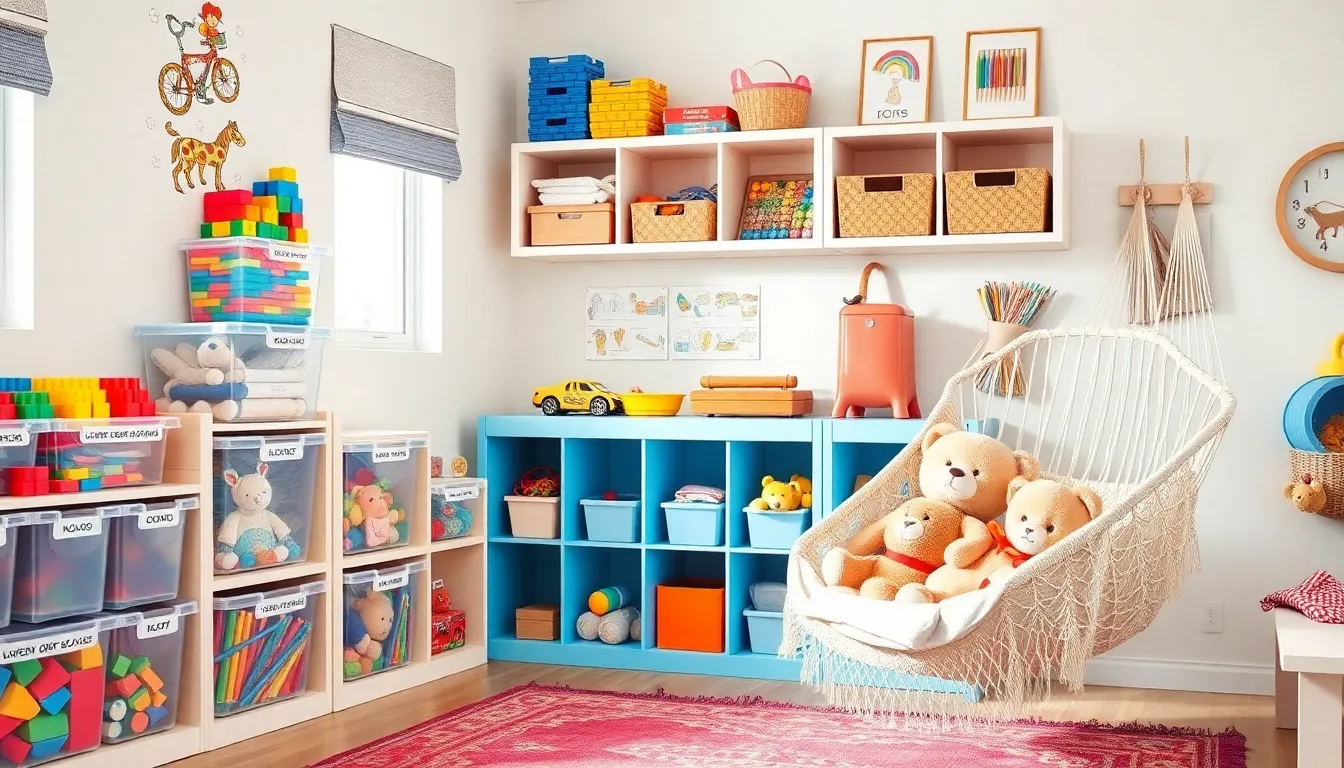
Organizing toys by category makes cleanup faster and helps children develop sorting skills. We’ll explore targeted storage answers for different types of toys that fit seamlessly into your home.
Building Block Storage Systems
Stackable containers offer the most efficient solution for building block storage, especially clear plastic bins that let children see their LEGO or Magna-Tiles at a peek. Clear bins eliminate guessing games and reduce the time spent searching for exact pieces. Wooden crates provide a more aesthetic alternative while maintaining the same organizational benefits.
Shelving units designed specifically for building blocks transform storage into an attractive display system. Installing dedicated shelves allows children to access their blocks independently while keeping pieces visible and organized. Open shelving encourages creative play by making all building options readily apparent.
Drawer organizers maximize space efficiency by using dividers and small bins within existing furniture. These systems work particularly well for smaller blocks and specialty pieces that might get lost in larger containers. Compartmentalized storage also teaches children to sort blocks by size, color, or type.
Art Supply Organization
Cubbies and shelves create designated zones for art supplies like paints, markers, and crayons, preventing the common problem of scattered materials throughout the house. Dedicated art storage areas encourage creativity while maintaining order. Clear labeling helps children return supplies to their proper locations after use.
Overhead storage units keep less frequently used art supplies accessible yet out of daily traffic areas. These elevated answers work especially well for expensive or delicate materials that require adult supervision. Wall mounted cabinets free up valuable floor and desk space for active art projects.
Portable carts with drawers transform art supply storage into a mobile creative station. Rolling carts allow art activities to move from room to room while keeping all supplies contained. Multiple drawer levels provide natural organization for different types of materials.
Stuffed Animal Storage Answers
Hanging hammocks create charming storage that doubles as room decor while keeping stuffed animals off floors and furniture. Corner hammocks maximize unused vertical space and add a cozy touch to bedrooms or play areas. Children can easily toss stuffed animals into hammocks during cleanup time.
Storage baskets offer traditional yet effective answers for stuffed animal organization, keeping beloved toys visible and accessible. Large woven baskets complement most room aesthetics while providing ample space for collections. Open basket storage encourages children to put toys away independently.
Stackable crates build customizable storage systems that grow with expanding stuffed animal collections. Wooden or plastic crates create tower configurations that fit various room layouts. Modular systems allow easy reconfiguration as storage needs change over time.
Stylish Toy Storage Ideas That Match Your Decor
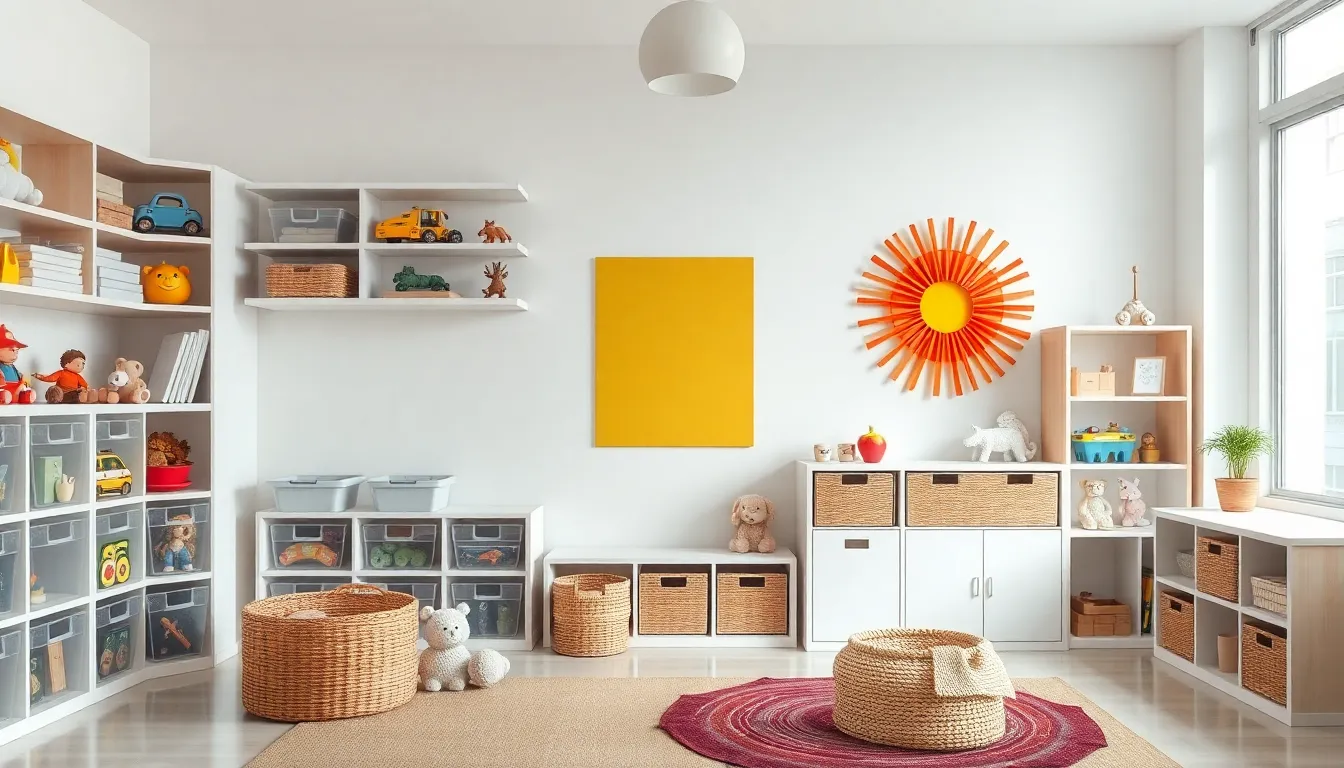
Creating storage answers that complement your home’s aesthetic transforms toy organization from an eyesore into a seamless design element. We’ll explore three distinct decor styles that prove functional storage can be both beautiful and practical.
Modern Minimalist Storage
Modern minimalist toy storage emphasizes clean lines and functional design that blends effortlessly with contemporary interiors. Sleek, low profile shelving units from IKEA create an airy feel while providing accessible storage for children. Stackable acrylic containers offer transparency that helps kids locate toys quickly without disrupting the room’s clutter free environment.
Modular storage bins work perfectly for this aesthetic because they maintain visual consistency while adapting to changing toy collections. Open shelving systems keep the space feeling spacious and uncluttered, following minimalist principles of “less is more.” Transparent storage answers ensure toys remain visible to children while maintaining the streamlined appearance that defines modern design.
Rustic Farmhouse Toy Organization
Rustic farmhouse toy organization brings warmth and character through natural materials and vintage inspired pieces. Repurposed wooden dressers with distressed paint finishes provide ample storage while adding authentic farmhouse charm to any room. Wire baskets and galvanized bins complement this style perfectly, offering practical storage that looks intentionally curated rather than purely functional.
Vintage wooden crates create excellent modular storage that can be stacked or rearranged as needed. Open shelving with woven baskets adds texture and visual interest while keeping toys organized and accessible. Antique apothecary cabinets serve as unique storage answers with multiple small drawers perfect for organizing tiny toys, art supplies, and create materials.
Colorful Kid-Friendly Storage
Colorful kid friendly storage makes organization captivating and fun for children while maintaining visual appeal in shared spaces. Bright storage bins in rainbow colors help kids identify where different toys belong, fostering independence and organizational skills. Painted bookshelves in cheerful hues transform storage into decorative focal points that celebrate childhood creativity.
Whimsical storage poufs and bean bags with hidden compartments provide seating while concealing toys from view. Multi colored bins and playful labels featuring pictures or symbols help non readers participate in cleanup activities. Clear containers mixed with colorful options create visual variety while maintaining the practical benefit of visible toy storage.
Portable Toy Storage Ideas for Easy Cleanup

Mobility transforms our approach to toy organization. These answers let us move storage where we need it most.
Rolling Cart Systems
Rolling carts create mobile units that flow seamlessly from room to room, making cleanup effortless for busy families. These versatile storage answers often feature multiple compartments that help us sort toys by type or activity. We can conveniently tuck them away when play time ends.
Benefits of rolling cart systems:
- Shared spaces: Perfect for homes where multiple rooms serve as play areas
- Organization: Multiple tiers allow categorization of different toy types
- Accessibility: Children can easily reach toys at their level
- Space efficiency: Carts fit into corners or under tables when not in use
Many rolling carts come with removable bins or baskets that make sorting even easier. We’ve found that metal frame carts with fabric bins work particularly well because they’re lightweight yet sturdy enough to handle heavy toys like building blocks.
Toy Storage Bags and Totes
Flexible storage bags and totes allow for quick pickup and transport of toys throughout our homes. Canvas, fabric, and mesh materials offer durability while remaining lightweight and portable. These storage answers often feature child safe closures or sturdy handles that make them easy for little hands to manage.
Popular bag and tote options:
- Canvas totes: Washable and sturdy for everyday use
- Mesh bags: Perfect for bath toys and outdoor equipment
- Drawstring bags: Quick closure for rapid cleanup sessions
- Handled containers: Easy transport between rooms
We recommend choosing bags with reinforced bottoms for heavier toys like cars or action figures. The portability factor means we can grab toys for trips to grandparents’ houses or outdoor play dates.
Stackable Container Answers
Stackable containers maximize vertical space, which is essential for small play areas in our homes. These containers are available in plastic, fabric, or wood materials and are designed to be sturdy and easy to access. We can categorize toys by type and customize the system as our children’s needs change.
Stackable container advantages:
| Feature | Benefit |
|---|---|
| Vertical storage | Saves floor space |
| Clear visibility | Easy toy identification |
| Modular design | Grows with toy collection |
| Secure stacking | Prevents toppling accidents |
Plastic containers with snap on lids work well for create supplies and small building pieces. Fabric containers with open tops are perfect for stuffed animals and dress up clothes. We’ve discovered that labeling each container with pictures helps young children identify where toys belong, making independent cleanup more achievable.
Smart Toy Storage Ideas with Labels and Systems
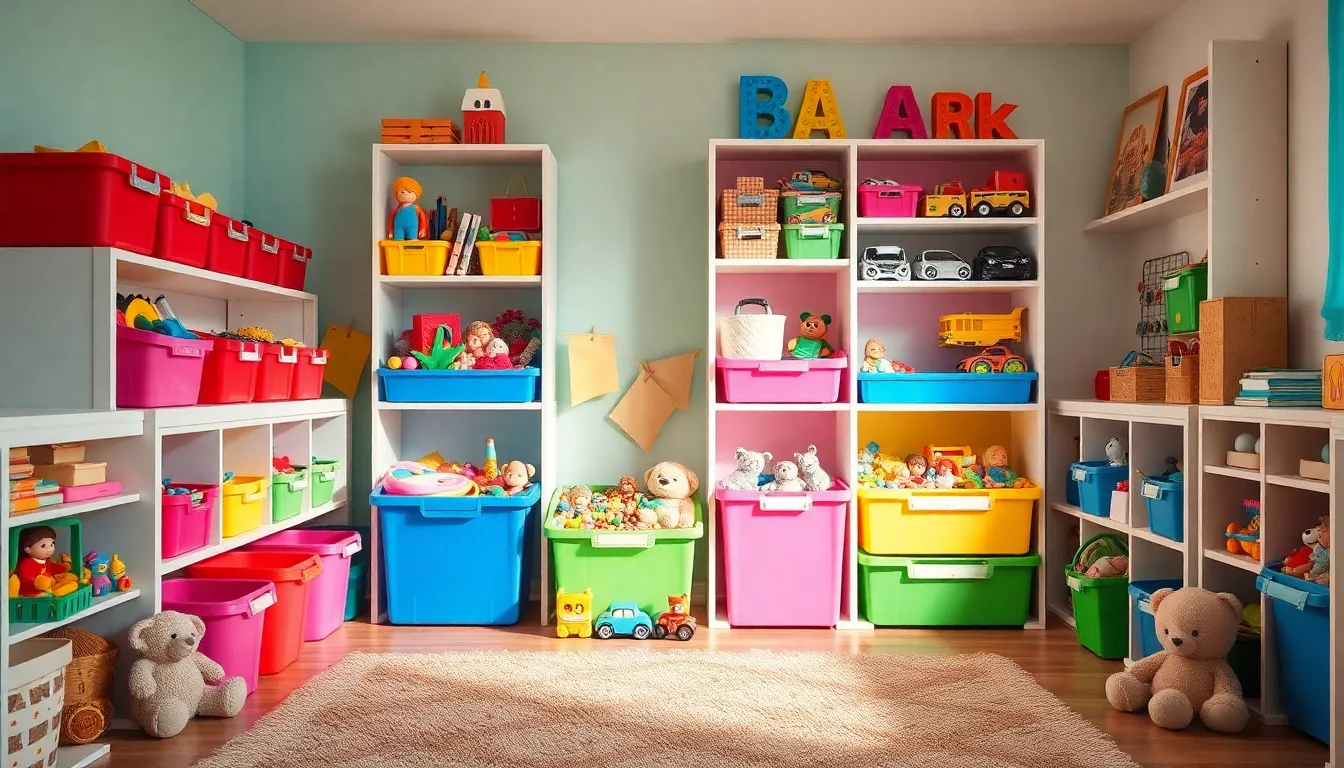
Smart labeling systems transform chaotic toy collections into organized spaces that children can navigate independently. We’ll explore proven methods that make cleanup faster while teaching valuable organizational skills.
Color-Coded Organization Methods
Color-coded bins create instant visual recognition for different toy categories. Red bins work perfectly for building blocks like LEGOs and wooden blocks, while pink containers can house dolls and dress-up accessories. We recommend establishing consistent color associations throughout your home so children quickly learn the system.
Colorful storage units make organization visually appealing and easy to navigate. Bright yellow bins can store vehicles and cars, blue containers work well for puzzles and games, and green bins are ideal for outdoor toys like balls and jump ropes. This method helps children develop sorting skills while making cleanup feel like a game.
Multiple color systems work effectively when you have various toy types. Use warm colors (red, orange, yellow) for active toys like sports equipment and musical instruments, while cool colors (blue, green, purple) can organize quiet activities such as books and art supplies.
Picture Label Systems for Non-Readers
Images on labels help non-readers identify what belongs in each bin or basket instantly. We suggest using clear photographs of the actual toys rather than cartoon drawings, as real images provide better recognition for young children. Print these pictures on durable cardstock or laminate them for longevity.
Visual cues like icons and pictures make it easier for children to return toys to their correct places. Simple symbols work well too – a building block icon for construction toys, a teddy bear image for stuffed animals, or a crayon picture for art supplies. These visual markers eliminate guesswork and reduce cleanup frustration.
Digital labeling systems are becoming increasingly popular for tech-savvy families. QR codes can link to photos or videos showing exactly what belongs in each container, though traditional picture labels remain more practical for daily use.
Rotation Storage Strategies
Rotating toys regularly keeps children engaged and interested in their existing collection. We recommend keeping only one-third of toys accessible while storing the remaining two-thirds in labeled containers. This approach prevents overwhelming play spaces and makes “new” toys appear every few weeks.
Storage and retrieval systems work best when you establish a regular rotation schedule. Mark containers with dates or seasons to track rotation timing, and involve children in selecting which toys to store away. This process teaches decision-making skills while maintaining excitement about their toy collection.
Less frequently used toys should be stored in easily accessible locations for periodic retrieval. Upper shelves or closet storage work well for rotation bins, and clear containers help you quickly identify which toys are ready for the next rotation cycle.
Conclusion
Creating an organized and functional toy storage system doesn’t have to expensive or overwhelm your living space. We’ve shown you that with a little creativity and strategic planning you can transform any chaotic play area into a well-organized haven that works for both parents and children.
The key lies in choosing storage answers that match your family’s lifestyle and your child’s developmental needs. Whether you’re working with a small apartment or a spacious playroom these ideas can be adapted to fit your unique situation.
Remember that the best toy storage system is one that grows with your family and encourages children to take ownership of their belongings. Start with one or two strategies that resonate with you and gradually build your organizational system from there.
Frequently Asked Questions
What are the best toy storage solutions for small spaces?
For small spaces, maximize vertical storage with wall-mounted organizers and under-bed storage bins. Multi-functional furniture like storage ottomans serves dual purposes. Use over-the-door organizers and stackable containers to make the most of every inch while keeping toys accessible and organized.
How can I create DIY toy storage on a budget?
Transform everyday items into storage solutions by repurposing cardboard boxes with decorative paper, using mason jars for small toys, and creating fabric storage cubes. These budget-friendly options cost significantly less than store-bought alternatives while allowing creative customization to match your home’s decor.
What toy storage works best for different rooms?
Living rooms benefit from stylish storage ottomans and rolling caddies for quick cleanup. Bedrooms work well with under-bed storage and wall-mounted hammocks for stuffed animals. Playrooms need clear drawer units and modular systems for maximum organization and easy access to toys.
How should I organize toys by age group?
Toddlers need low, open baskets for safe access. School-age children benefit from colorful bins that encourage sorting skills. Teenagers prefer customizable shelving and hidden storage options that maintain a mature aesthetic while maximizing space efficiently.
What’s the best way to organize toys by category?
Use stackable containers for building blocks, designated cubbies for art supplies, and hanging hammocks for stuffed animals. Category-based organization streamlines cleanup, helps children develop sorting skills, and makes finding specific toys much easier during playtime.
How can toy storage match my home decor?
Choose storage that complements your style: sleek shelving and transparent containers for modern minimalist homes, repurposed dressers and wire baskets for rustic farmhouse decor, or bright colorful bins for kid-friendly spaces that maintain visual appeal.
What are the benefits of portable toy storage?
Portable storage like rolling carts and storage bags allows easy movement between rooms and quick cleanup. These solutions offer flexibility for changing play areas, make tidying more manageable, and help contain messes in specific spaces throughout your home.
How do labeling systems help with toy organization?
Labels transform chaotic toy collections into organized systems. Color-coded labels help children identify categories quickly, while picture labels work perfectly for non-readers. Clear labeling systems encourage independence and make cleanup routines more efficient and successful.
Should I rotate my child’s toys?
Yes, toy rotation keeps children engaged and prevents overwhelming play areas. Store some toys away and rotate them weekly or monthly. This strategy makes “old” toys feel new again, reduces clutter, and helps children focus better on available toys.
How can I make cleanup fun for children?
Incorporate storage into imaginative play with built-in playhouses featuring storage compartments. Use colorful, themed storage bins and create cleanup games with timers. Making organization part of play encourages children to view tidying as an enjoyable activity rather than a chore.

